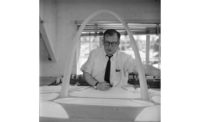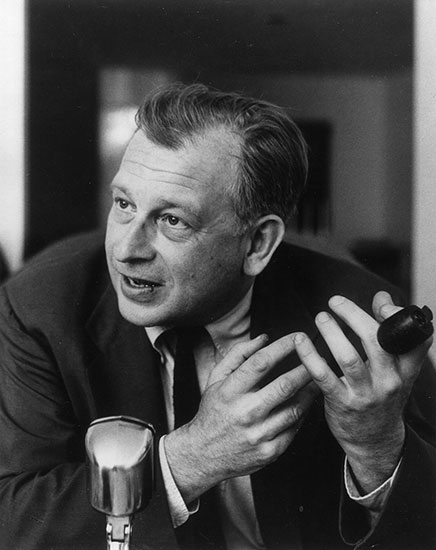Genesis of Genius
Case Study: Eero Saarinen
In this excerpt from The Creative Architect, Serraino reveals the intriguing findings that both motivated Saarinen and made him insecure.

Eero Saarinen
Saarinen had designed the sleek, glass-curtain-walled General Motors Technical Center in Warren, Michigan, in 1956.
Photo © Ezra Stoller/Esto

Eero Saarinen
Of the 40 architects who agreed to participate in the study, Eero Saarinen was considered by many the most creative.
Photo © Photo Quest / Getty Images

Eero Saarinen
In his “mosaic construction test,” Eero dared to make the entire work white.
Photo © IPAR



Editor’s Note: In June, The Creative Architect: Inside the Great Midcentury Personality Study, by Pierluigi Serraino, will be published by Monacelli Press. The book is based on psychological tests conducted by the University of California, Berkeley, in 1958–59 to try to determine what promotes creativity in architects. RECORD presents excerpts of three case studies of the leading architects of the day—Eero Saarinen, Philip Johnson, and Richard Neutra—along with the author’s summary of the goals, methodology, and findings of this unusual, almost-forgotten investigation. Go back to the main article.
Saarinen was dyslexic. As a coping mechanism, he sketched his thoughts and ideas during his interview with psychologist William Smelser, who noted Eero’s quest for enduring acknowledgement for his work. He needed to assert his own autonomy independently of his father, Eliel: “He answered the question about his ‘best work’ in terms of what his father said and what St. Peter might think,” Smelser wrote. “The subject is closely identified with his father (a famous architect) but received little affection from him.” Smelser also observed: “He has strong status concerns about his own greatness, and apparently this is a function of his concern about being independent of his father’s name.”
Smelser depicted a rather guarded individual, with peculiar views on women: “He is rather contemptuous of women in a rather tactless way,” he wrote, and explained in some background notes, “He has a rather Euro-pean view of women as non-intellectual, nurturing, and subordinate to males. He is also fearful of them because of his own unresolved dependency needs . . .” Smelser noted that Saarinen “has a penchant for pointing out faults in others.” Furthermore, according to the psychologist, “There is also a psychopathic element to the subject in that he is somewhat manipulative and devious and tries to see what he can get by with. At the same time there is a feeling of responsibility to communicate and to teach and persuade others.”
Saarinen worked deep into the night, retiring around 1:30 a.m., and waking up tired at 8:30 a.m. In earlier years he used to arrive at the office at 10 a.m., but after his second marriage [to art and architecture critic Aline Louchheim], he would get there earlier. He stated that none of his creative output would occur in the morning.
When asked to “list those things which you have done which you consider innovations in the field of architecture or design,” he replied: “Innovation is the wrong word but I believe I have contributed much to architecture and furniture design—myself and my associates created the first curtain wall, first neoprene gasketing of architectural windows and first in many other new developments.” It is unclear why Saarinen believed himself to be the inventor of the curtain wall system, given that projects completed earlier in the century already featured that building skin technology. In listing his own accomplishments, Saarinen—age 48 at the time of the study—exhibited no doubt about his own central role in modern architecture.
Saarinen’s childhood was trying. Regarding his first 12 years in Finland, he said he was the favored child in the family but did not have many playmates. He was essentially home-schooled and learned to read from the house servants, but was never fast at it. He eventually went to school at age 10, where he was “teased” because he was fat. “School was more difficult than here. I was unhappy,” he recalled. When Eliel moved his family to the U.S., Eero entered the fifth grade at age 12. By the end of high school he had barely five and a half years of formal schooling.
His father sent Saarinen to study sculpture at the Académie de la Grande Chaumière in Paris for one year. When he returned, he entered the architecture program at Yale, earning a Bachelor of Arts after three years. Contrary to what is typically stated about his apprenticeship period, Eero wrote that he spent barely three weeks as a designer for Norman Bel Geddes and just four months as a draftsman in his father’s office. He seemed to think the question didn’t apply to the years from 1938 to 1950 when son acted as a partner of the father.
With his drawing skill Eero stood out from the beginning: “I could get through anything with drawings,” he pointed out. His precocity helped build his self-esteem and was a way to connect with his father, who “was always remote to me.” The yearning for his father’s attention and the concurrent need to be seen independently from him were the recurrent themes of his life; this strenuous emotional race with Eliel partially explained his legendary stamina and ability to work relentlessly on his projects. At Yale Saarinen started finding himself: “I value what I do with my hands—not reading. During these three years I did very well. It was the first time the gap was closed between friends and work.”
Additional remarks about his father displayed Eero’s continuous focus on him and give insight into his own artistic trajectory: “We ate together [but outside of that] he was concerned with his work . . . He was a prima donna—he could only build monumental buildings . . . My father’s and my birthday were on the same day—further identification [smiles slightly].” His need for social recognition was very strong during his adolescence: “[My] dominant conflict was to be liked—not by lesser members of the class though.” As his confidence in his talent grew, he acted defiantly. At Yale he would deliberately sleep in the first row of non-architecture classes. Asked if he considered himself to be a creative architect, he responded unabashedly: “Yes. Well, both in invention and form . . . I am fairly aware of what’s going on. I have sensitivity.” Of his peers participating in the creativity study, he deemed that only five or six were good architects: “you have got them all in your program.”
At the end of the interview, Saarinen asked Smelser if he found anything “unusual or odd” about the architect. In the personality assessment test of 10 traits, with rankings on a scale of 1 to 9, Smelser gave Eero only a 3 for Maturity and Responsibility and a 4 for Personal Stability and Adjustment. Eero fared much better for Sense of Destiny with a 9, and an 8 for Intellectual Competence. As an architect at the top of his game at 48, Saarinen seemed to pay an inordinate amount of attention to how others perceived him. He was indeed independent in his architectural exploration, yet peculiarly dependent on others’ approval for his own self-acceptance.





